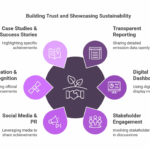
How to Show Your Brand Is Truly Eco-Friendly
Let’s face it, consumers today are smarter, savvier, and more conscious than ever before. Saying “eco-friendly” on your product just won’t cut it anymore. They want proof. What’s behind your claim? How does your product actually help the planet? And many more questions given the heat of climate change and pollution that every individual is going through.
Brands that can confidently answer these questions with real data are the ones building trust, loyalty, and a reputation for doing the right thing. Your end consumers want clear, honest information about the environmental impact of what they buy, and brands that fail to deliver risk losing their trust.
So how can your brand deliver this proof?
One effective way is through Life Cycle Assessment (LCA), a comprehensive method for evaluating the environmental impact of a product throughout its lifecycle.
What Is Life Cycle Assessment (LCA)?
Before diving into LCA, let’s break down the basics. What does the life cycle of a product actually mean? Think of it as the journey your product takes from the moment raw materials are extracted to the time it’s finally disposed of. Every step along the way impacts the planet, and understanding this journey is key to figuring out how eco-friendly your product really is.
Here are the 5 Phases of a Product’s Life Cycle, often called “cradle-to-grave”:
- Raw Material Extraction : It all starts here mining, harvesting, or sourcing the materials needed to make your product. This phase often has a big environmental footprint.
- Manufacturing & Processing : Once materials are gathered, they’re shaped into the product. This step includes all the energy, resources, and emissions that go into production.
- Transportation : How does your product get to where it needs to be? Whether by road, rail, or air, every mile adds to its carbon footprint.
- Usage & Retail : This phase looks at how the product is used and the energy or resources it consumes during its lifetime. Retail processes, like storage and display, also play a role.
- Waste Disposal : The final step: What happens when the product’s life is over? Does it end up in a landfill, or can it be recycled or composted?
Breaking the lifecycle into these clear stages helps brands pinpoint where they can reduce their environmental impact and make meaningful changes.
By assessing each phase, LCA turns sustainability into more than just a buzzword, it gives you actionable insights to improve your product and reduce its footprint.
Why It Matters for Your Brand
Proving your product’s eco-friendliness isn’t just a “nice-to-have” any more. With all the emerging government regulations and consumer demand it’s your ticket to standing out in a crowded market and being compliant. Here’s why:
- Win Consumer Trust: When you’re upfront about your impact, people notice. They’re more likely to trust and choose your brand over others.
- Stay Ahead of the Competition: In a world full of greenwashing, transparency makes you the real deal and that’s what today’s buyers want.
- Be Ready for Regulations: Sustainability laws are getting stricter. LCA gives you the data you need to stay compliant without scrambling at the last minute.
- Find Efficiency: Measuring your impact often highlights waste and inefficiencies. Cutting them not only helps the planet but can save you money too.
Future-Proof Your Brand with LCA
Sustainability isn’t just a trend—it’s the new standard. Whether you’re looking to build products which are better for planet, earn certifications, or build consumer trust, a Lifecycle Assessment (LCA) gives you the clarity and data to make smarter, greener decisions. Brands that take action today will lead tomorrow’s market.


